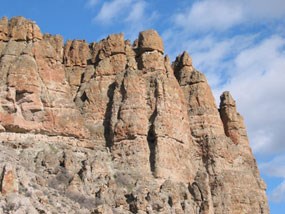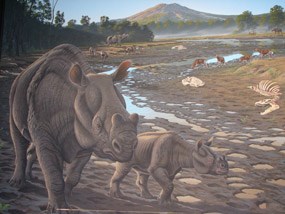
The Clarno Nut Beds formed when massive mudflows engulfed a forest.The Clarno strata consist of thick layers of many different rock types. A small portion of these sequences was formed when massive walls of mud, ash, and debris came crashing down the slope of a volcano, engulfing the surrounding forest and its animal inhabitants. Over time, the mud, silt, soil, and rocks of these “lahars,” along with wood, nuts, seeds, and leaves from the forest floor, were cemented together by silica.
This cementing, or hardening of the rocks, was possibly aided by minerals from nearby hot springs. This combination left a solid cliff made up of sand, silt, and clay that encased the jumbled remains of a forest. Within the depths of the Clarno strata is a layer of volcanic sediments deposited by a river containing some of the more remarkable mammal fossils ever found in North America. Seasonal flooding swept a large variety of dead animals and plants to an existing point bar. A point bar forms when sediments, such as silt, clays, sand, and gravel, drop out as the water rounds a bend and loses energy, building up a spit of land. With each successive flood, more sediment layers were added. Over time, these buried bones became the fossils of the Hancock Mammal Quarry.

Forty-four million years ago, central Oregon was a hot, wet, semitropical place filled with a wide diversity of plants. Imagine a semitropical forest in the present day and a climate where there is no summer or winter, but where many of the trees seasonally lose their leaves. This is an ancient Oregon forest. We know this based on more than 175 species of fruits and nuts that are preserved in the fossil deposits known as the Clarno Nut Beds. None of the species found here still exist. Many of the plants recovered from this assemblage have modern relatives such as walnuts, chestnuts, oaks, bananas, magnolias, and palms. This semitropical forest echoed with the buzzing of insects; the squawks and cries of birds; and the footfalls of mammals. Most of these beasts are only vaguely familiar to us: creodonts – large meat-eaters similar to wolves or hyaenas but related to neither; Hyrachyus – a distant relative of the tapir; and brontotheres – large rhino-like plant eaters. In the swampy lakes lived crocodiles, catfish, and other organisms. 

The 40 million-year-old Hancock Mammal Quarry offers us a glimpse into a world of strange and interesting mammals. Picture a marshy stream in a warm, humid forest, where most of the plants are vaguely familiar. Dozens of strange-looking beasts gathered at this stream at different times, trampling over dead animals lying in the mud. The mammals that visited this backwater included Haplohippus – small leaf-eating horses; huge rhino-like animals called brontotheres; and Achaenodon – bear-like creatures similar to modern pigs. The large scavenger Hemipsalodon feasted on the carcasses, while cat-like animals hunted prey here. Why such a variety of animals were preserved at this site, but nowhere else, remains a mystery. |
Last updated: January 3, 2018
